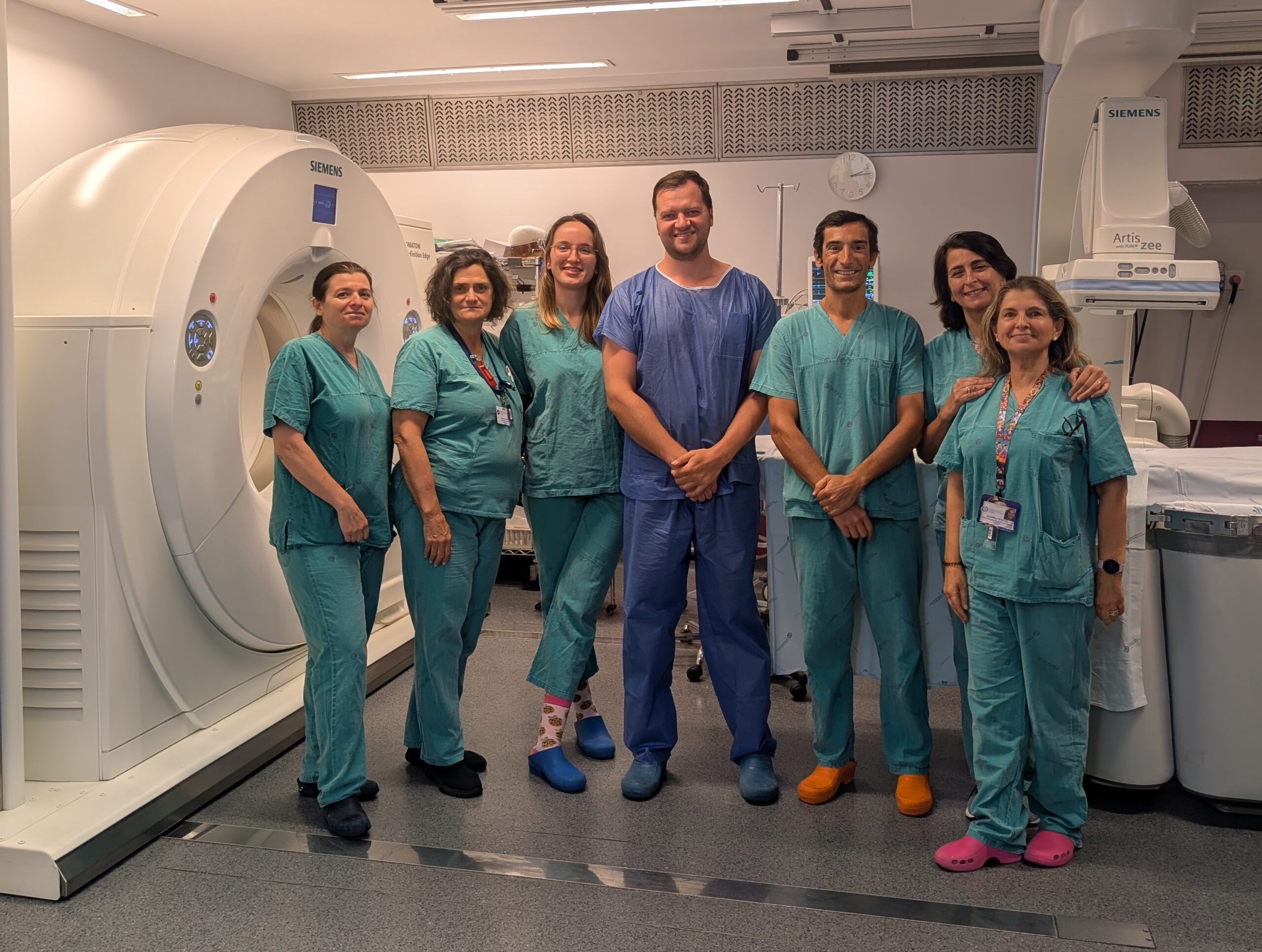CIRSE Fellowship report: Dr. Nauris Zdanovskis
My name is Nauris Zdanovskis. I spent one month at Curry Cabral Hospital in Lisbon, Portugal, as a CIRSE Fellow under the supervision of Prof. Tiago Bilhim. My goal was to gain exposure to complex interventional radiology procedures, experience the workflow of a high-volume European centre, and compare different approaches to techniques I use in my own practice in Riga, Latvia.
Daily structure and team atmosphere
From the very first day, I was welcomed as part of the team. Mornings began with reviewing the day’s patient list and discussing imaging studies and procedural plans. Each case was approached systematically. We considered the patient’s clinical history, comorbidities, and prior treatments, and then outlined the best interventional strategy. After procedures, there was usually a short debrief where technical points and outcomes were discussed.
This structure created a clear learning environment. It was not only about watching procedures but also about understanding the clinical decision-making that guided them. I noticed how consistently the team worked together — radiographers, nurses, anaesthesiology staff, residents, and fellows all had defined roles, and their coordination allowed even complex procedures to be performed smoothly.
Procedural experience
Uterine fibroid embolization
I observed several fibroid embolizations, all performed efficiently in sequence. The approach differed slightly from my home practice. The embolic materials used, as well as the sequence of catheterisation, varied. The goal was the same (complete devascularisation of the fibroids), but the methods showed me how much practice patterns can differ even within Europe. These variations encouraged me to reflect on which elements could be adapted in Riga to streamline our own workflow.
Microwave ablation under deep sedation
One of the most instructive experiences was observing microwave ablations (MWA) carried out under deep sedation rather than general anaesthesia. In my home centre, MWA is typically performed with general anaesthesia, which means greater involvement of anaesthesiology staff and longer preparation. At Curry Cabral, patients were comfortably sedated, and several lesions could be ablated in the same session. I found this approach impressive both from the efficiency standpoint and from the patient’s perspective. It demonstrated that with proper monitoring and a well-trained team, deep sedation can provide an excellent balance between patient safety and workflow efficiency.
Complex TIPS procedures
A valuable part of my fellowship was the exposure to TIPS (transjugular intrahepatic portosystemic shunt) procedures. I saw a number of challenging cases:
- TIPS revisions, including dilation of existing shunts for refractory ascites.
- Flow reduction procedures for patients with recurrent encephalopathy.
These cases stood out because such complex TIPS scenarios are relatively uncommon in my own practice. Observing how Prof. Bilhim and his team handled them — from vascular access to stent placement to haemodynamic assessment — provided me with technical knowledge and confidence to approach similar cases in the future.
Other procedures
In addition to these main groups, I observed bleeding control embolizations, where rapid vessel selection and embolic choice were key. I also saw biopsy methods, where sealant was applied through a coaxial needle to minimise bleeding, allowing outpatient liver biopsies with only a few hours of observation. A particularly interesting case was a translumbar dialysis catheter placement guided by CT and angiography. This is not a routine procedure in my own centre, but it is one that broadened my understanding of what IR can offer in difficult access situations.
Learning beyond the angio suite
What impressed me was not only the procedures themselves but also the clinical integration of interventional radiology. Patients were carefully selected, often in collaboration with hepatology, surgery, or gynaecology teams. This ensured that interventions were part of a broader treatment plan.
Patient communication was also a point of learning. I observed how procedures and their risks were explained clearly and concisely, even for complex interventions. Post-procedural care was pragmatic but safe, with short observation times and rapid return to outpatient status whenever possible.
What I will bring back
The fellowship provided several practical lessons I intend to apply:
- Advocating for greater use of deep sedation in ablation procedures, which could improve efficiency and reduce the burden on anaesthesia resources.
- Sharing technical insights from biopsies, fibroid embolizations, and complex TIPS with my colleagues.
- Reviewing the potential for shorter observation times after selected procedures.
- Strengthening the case for multidisciplinary IR pathways, particularly for hepatology patients.
Spending one month in Lisbon was a valuable professional experience. It offered direct exposure to procedures that are less frequent in my own centre and gave me new ideas for how to improve workflow and patient care.
What I appreciated most was the openness of the team. Prof. Bilhim and his colleagues were always ready to explain their approach, discuss alternative strategies, and involve me in daily practice. Their attitude created an environment where learning was continuous.
The fellowship also reminded me of the importance of exchange across centres. Seeing how the same procedures are approached in different hospitals highlights not only technical differences, but also the flexibility of interventional radiology as a discipline. It is encouraging to know that by adapting protocols to local resources and patient populations, high-quality outcomes can be achieved in many ways.
I am grateful to Prof. Tiago Bilhim for his guidance and for welcoming me into his department, to the IR team at Curry Cabral for their hospitality and professionalism, and to CIRSE for supporting this programme. The fellowship was a meaningful opportunity to learn, reflect, and grow as a clinician.

